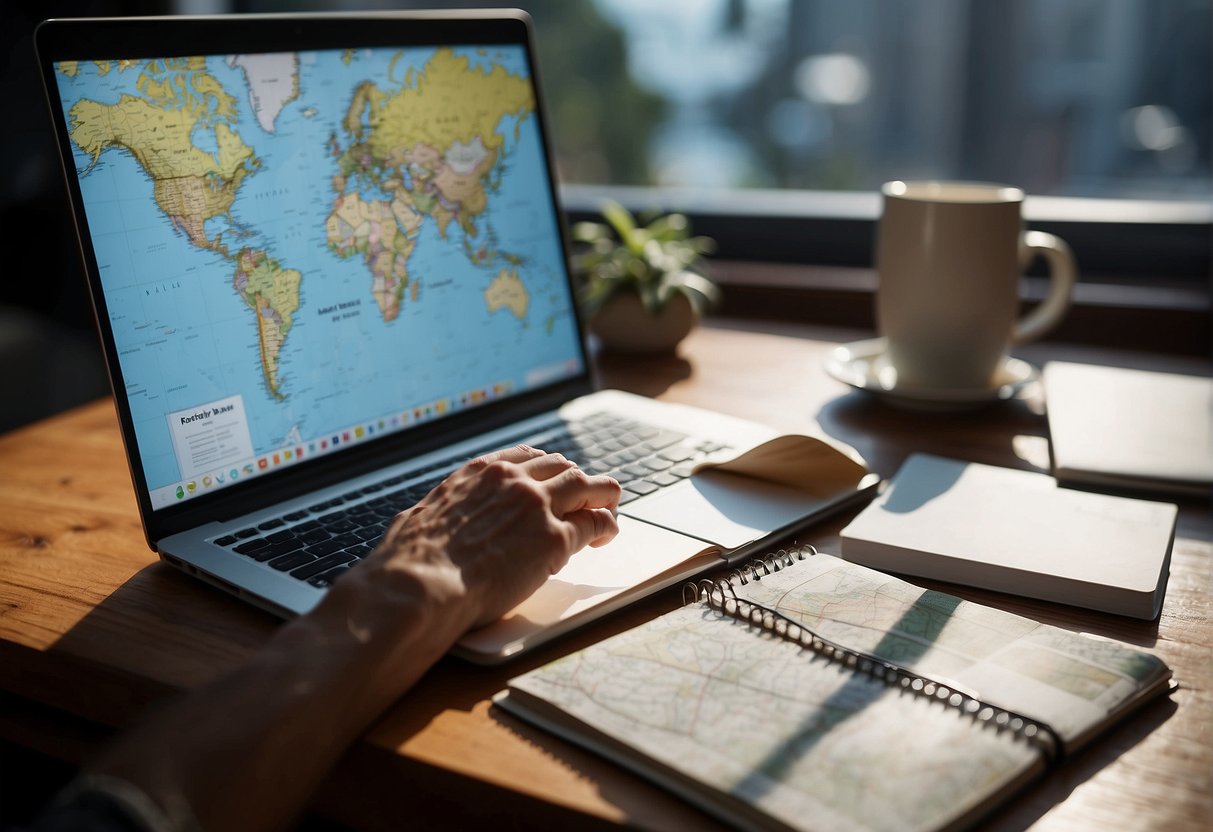

- Directory
- Recent
-
Featured
-
Featured
- Recent
-
- Programs
- Digital Nomad
- Side Gigs
- Resources
Select Page
10 people find this post amazing!

Embarking on a journey requires thoughtful preparation and a plan tailored to individual goals and preferences. Travel planning begins with defining the trip’s purpose which could range from leisure to adventure, from culture immersion to family visits. Recognizing this objective steers the entire planning process, from selecting the destination to penciling in activities on the itinerary.
Budgeting for a trip is the foundation that ensures travel plans are both realistic and enjoyable. Determining a financial plan early on helps in making informed decisions about transport, accommodation, and experiences. Smart budgeting allows for a balance between splurging on unique experiences and finding cost-effective alternatives.
With a defined objective and a clear budget, choosing a destination and crafting a detailed itinerary become more straightforward. From pinpointing locations to outlining day-to-day activities, each step mirrors personal interests and travel goals. Booking essentials such as flights and accommodations in advance helps secure better rates and avoid last-minute hassles, while preparing for departure involves packing, securing travel insurance, and ensuring all travel documents are up-to-date.
Before embarking on a journey, it is crucial for travelers to clearly define what they seek to achieve with their trip. The objectives determine the trip’s structure and set the stage for a fulfilling experience.
Travelers should begin by pinpointing the nature of the trip. Options range from a relaxing vacation to an adventurous weekend getaway, or perhaps a gap year aimed at personal growth. They may also consider a long weekend to recharge or a year-long trip for extensive exploration. Key to this stage is to align the trip type with personal interests and expectations.
Determining the trip length is a vital step. Travelers need to decide how much time they can dedicate—be it a short long weekend or a more extended period like a year-long trip. Factoring in constraints such as work obligations, budget, and seasonal considerations is necessary for setting realistic expectations.
| Trip Length | Description |
|---|---|
| Short | Typically a long weekend to a full week. Ideal for nearby or familiar destinations. |
| Medium | One to three weeks, balancing travel depth with time investment. |
| Long | A gap year or months-long journey allowing for comprehensive exploration. |
When looking at timing, they should contemplate the seasonality and events at their destination, which can impact both the experience and cost. Whether it’s a swift weekend getaway or a lengthy vacation, picking the right time is as crucial as the destination itself.
Effective budgeting is crucial for a successful and stress-free travel experience. It ensures that travelers can afford their desired activities and avoid financial strain. By calculating overall costs and implementing smart saving and expense management strategies, one can enjoy their trip without the burden of unexpected costs.
To calculate overall costs, one should start by estimating the major expenses: flights, accommodations, and transportation. Flight deals can significantly reduce airfare costs, and it is advisable to research and book cheap flights well in advance. Accommodations range from budget-friendly hostels to luxury hotels, and prices should be compared across multiple platforms to find the best rates.
Transportation expenses may include car rentals, train tickets, and local transit. A comprehensive list should be compiled and totaled to get a clear picture of the base travel budget. Additionally, daily spending on food, attractions, and miscellaneous items like souvenirs should be estimated. Here’s an example table outlining potential costs:
| Expense Category | Estimated Cost |
|---|---|
| Flights | $400 |
| Accommodation | $600 |
| Transportation | $200 |
| Food | $300 |
| Attractions | $200 |
| Miscellaneous | $100 |
| Total | $1800 |
Effective saving strategies are key to building a travel fund. Setting up a dedicated savings account with automated deposits can streamline the process. Regularly transferring a set amount or a percentage of one’s income into this account can help accumulate funds over time. Creating a timeline for how long one needs to save to meet their travel budget is wise.
Credit cards can be useful tools for managing travel expenses and earning rewards. Many offer points or miles that can be redeemed for airfare or accommodations. However, one must be careful to spend within their means to avoid debt. An emergency fund should also be considered to cover unforeseen costs without impacting the planned budget.
Budgeting does not only involve saving but also the tactical management of expenses. Monitoring spending during the trip and choosing cost-effective options can prevent overspending. It is beneficial to use apps or spreadsheets to track expenditures against the planned budget in real-time. This active approach to financial management allows travelers to make adjustments as needed.
When planning a trip, selecting the right destination is crucial. This involves weighing both geographical preferences and cultural offerings, ensuring an experience that resonates with the traveler’s desires.
Travelers must first decide between a domestic getaway or venturing abroad. Staying within the USA can offer diverse landscapes from the beaches of California to the bustling cities like New York. International journeys might lead to the historic streets of Europe, exploring Italy‘s rich heritage or embracing Iceland’s otherworldly terrains. Each destination’s visa requirements, travel insurance, and transportation options should be considered.
The intended travel destination’s culture and climate play pivotal roles in the overall experience. Countries in South America or Mexico might entice with lively festivals and warm weather, while a European tour could offer an arts-rich expedition with changing seasons.
Climate:
Festivals and Events:
Choosing a destination involves considering the seasonal climate and cultural offerings to ensure they align with the traveler’s expectations and interests.
Creating an itinerary involves careful planning and consideration of one’s travel goals. It’s essential to allocate time for both planned activities and spontaneous exploration.
When they start itinerary planning, travelers should begin by listing the activities and must-dos that they wish to experience during their trip. This list should be organized by priority and structured by location to maximize efficiency and minimize transit time. Here’s a simple table format one could use to outline their daily plan:
| Day | Location | Activity | Time | Notes |
|---|---|---|---|---|
| Monday | Tokyo, Japan | Visit Tsukiji Fish Market | 9:00 – 11:00 AM | Arrive early to catch auctions |
| Explore Senso-ji Temple | 1:00 – 2:30 PM | Wear appropriate attire | ||
| … | … | … | … | … |
Directions between activities should be determined ahead of time, whether that involves mapping out walking routes or scheduling public transportation.
Scheduling should strike a balance between structured events and free time. Free time allows travelers to discover the locale organically or rest, which is especially important during longer trips. Structured events, such as guided tours or reservations, are planned commitments that require adherence to a specific time. When arranging organized events, one should ensure they are not back-to-back to avoid a rushed experience.
During the trip planning process, travelers might structure their travel itinerary as follows:
This layout provides a harmonic balance and keeps the itinerary flexible, yet well-organized.
When planning a trip, securing transportation and accommodation are paramount to ensure a smooth journey. These elements form the foundation of your travel plans.
Travelers must decide between various transportation options, such as flights, trains, and buses. They should consider factors like cost, duration, and comfort when selecting their mode of transport. For flights, comparison websites and airlines’ direct sites are both viable booking sources.
Accommodation choices range from hotels and inns to vacation rentals like Airbnb and VRBO. Choosing the right place to stay revolves around location, amenities, price, and personal preferences.
| Transport Option | Booking Source | Accommodation Type | Booking Source |
|---|---|---|---|
| Airplane | Airline websites | Hotel | Booking.com |
| Train | Rail service websites | Airbnb | Airbnb website |
| Bus | Bus company websites | Inn | Direct contact |
| Rental Car | Rental company websites | VRBO | VRBO website |
Once transportation and accommodations are selected, making reservations is vital. This secures your spot and often offers better rates than last-minute bookings. After booking, obtaining a confirmation is crucial.
Travelers should note confirmation details:
It is wise to keep all confirmations accessible, either in digital format on a device or printed copies, and to review them before departure.
Before setting off on a journey, it is crucial to ensure all documentation is in order and packing is thoughtfully completed. Efficient preparation lays the foundation for a seamless trip.
Every traveler must verify their passport is valid for at least six months after the return date. Depending on the destination, a visa may be required; travelers should consult the destination country’s embassy website for specifics.
| Requirement | Description |
|---|---|
| Passport | Valid for 6 months beyond return date. Check for blank pages if needed. |
| Visa | Required for certain countries. Application times vary, so plan ahead. |
For multi-destination trips, one should confirm if additional documentation is needed and if their current visa allows multiple entries.
Packing should align with the trip’s directions and activities. A versatile approach is to pack layers to accommodate various weather conditions, using a list to ensure all essentials are included.
The night before departure, travelers should double-check their packing and review their plan a trip for any updates or changes. This includes confirming the direction to the airport or initial destination to avoid any delays.
In travel planning, utilizing a range of digital tools and informative resources can streamline the process, offering up-to-date information and personalized options.
Travelers can streamline their planning process by harnessing various online platforms. Google Flights facilitates flight comparisons, enabling users to find competitive fares and optimal flight times with ease. For accommodation and activity reviews, TripAdvisor offers comprehensive insights, while Pinterest and Instagram provide visual inspiration for destinations. A travel planner app or online tool can be invaluable in consolidating itineraries.
When seeking in-depth destination knowledge, travel guides and travel guidebooks from reputable sources such as Lonely Planet deliver well-researched and reliable information. They often come in both physical and digital formats for convenience. Additionally, travel blogs can offer personalized accounts and unique tips that may not be found in traditional guides.
By engaging with these tools and resources, travelers can make informed decisions and enhance their overall travel experience.
Travel planning doesn’t stop when the journey begins. On the road, travelers must adapt to new environments and stay vigilant about their safety and health. These tips will aid in enriching the travel experience while ensuring well-being.
When arriving at a new destination, it’s crucial for travelers to immerse themselves in the local culture. They should conduct thorough research on their destination, including local customs, language, and etiquette to interact respectfully with residents. Weather plays a significant role in the travel experience, so understanding the forecast allows for appropriate clothing and gear.
Travelers should prioritize their safety and health while exploring. This involves staying informed about the local safety standards and health risks. Keeping emergency contact information and knowing the location of the nearest embassy or consulate is essential.
When travelers make an effort to document their experiences and engage with others on their journey, they significantly enhance the value and reach of their travel.
Documenting travel experiences serves as a personal guidebook for reflection and future trips, while also providing inspiration for others. Utilizing platforms like Instagram and Pinterest allows travelers to share their sightseeing triumphs, road trip chronicles, and those once-in-a-lifetime moments with a broader audience. They can categorize their posts using hashtags or dedicated boards to streamline content for followers seeking specific travel inspiration.
Fostering connections with locals enhances cultural understanding and often leads to more profound travel experiences. Tools for integration include language learning apps and local meetups. Meanwhile, connecting with fellow travelers can provide unique insights and add to one’s travel companion network. Engaging in online travel communities or groups opens doors to shared tips and real-time travel advice.
After a trip, travelers should take the time to reflect on their experiences and share their stories. This not only allows for personal growth but also aids in planning future journeys.
Travelers should comprehensively review their vacation once back home. They may consider creating a structured approach to reflection by using a simple table format:
| Aspect of Trip | Reflections | Potential Improvements |
|---|---|---|
| Itinerary Planning | Evaluate the efficiency of the itinerary. | Identify places that needed more time. |
| Accommodation Choice | Assess the comfort and convenience of stay. | Consider alternative areas or lodging options. |
| Cultural Experiences | Reflect on cultural interactions and learnings. | Research more about local customs beforehand. |
Mapping out experiences in this manner helps travelers understand what worked well and what could be enhanced for future trips.
Sharing travel experiences can be a rich source of information and inspiration for both the storyteller and the audience. They might:
When discussing travel stories, it’s beneficial to highlight specific aspects of the trip planning process:
Such sharing can transition seamlessly into planning future vacations, where travelers can leverage their knowledge and past experiences to curate even more fulfilling journeys. They might create lists of destinations to visit next, using bullet points to organize their thoughts:
By sharing their experiences and considering what they have learned, travelers set a foundation for more successful and enriching future adventures.
Planning a trip can be a complex task, especially for beginners. This section provides concise, factual answers to common questions about travel planning.
One must first define their travel goals and preferences, then research destinations accordingly. They should book flights and accommodations early, plan out activities and sightseeing spots, and ensure they have all necessary documents.
Beginners should start with thorough research on their chosen destination, considering factors such as weather, local customs, and costs. They need to prioritize must-see locations and experiences while leaving room for flexibility in their plans.
Calculating the total cost involves accounting for transportation, lodging, food, activities, and emergencies. Tracking expenses through a spreadsheet or budget app helps manage finances and avoid overspending.
Travelers often use apps like TripIt or Google Trips to consolidate reservations and itineraries in one place. Mapping apps and budgeting tools are also widely recommended for keeping trip details organized and accessible.
For an extended trip of six months, planning should start at least 9 to 12 months in advance. This allows ample time to research destinations, secure early bird deals on accommodations or flights, and sort out any visa requirements.
When planning an international trip, one must consider visa requirements, health and travel insurance, vaccinations, and how to handle finances abroad. Staying informed about the political and health climate of the destination is also crucial.
Planning a successful journey involves careful consideration of numerous factors. One should start by determining a budget, followed by choosing a destination that aligns with their interests and financial constraints. Research is essential to uncover the best accommodation options, local transportation, attractions, and activities.
A well-structured itinerary can enhance one’s travel experience. It’s advisable to be flexible, as unexpected changes may occur. Travelers should always consider purchasing travel insurance for unforeseen circumstances.
Safety is paramount, so one must always be aware of the local emergency numbers and have a plan for medical situations. Lastly, respecting the local culture and environment is vital for a responsible and enriching travel experience.
Before embarking on a journey, travelers should review all plans carefully to ensure a smooth and enjoyable trip. Staying organized, informed, and prepared forms the cornerstone of a memorable and hassle-free travel adventure.
Table of Contents

Achieve Your Goals Now!
